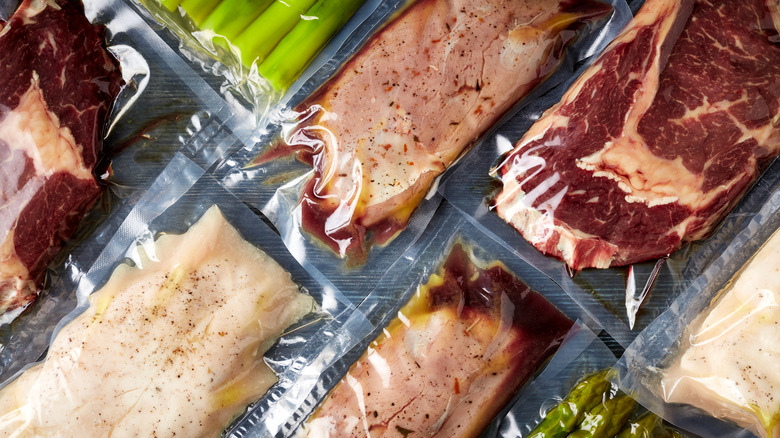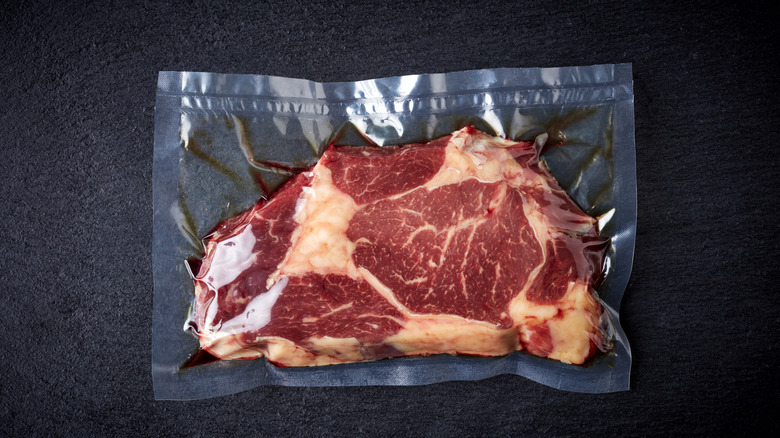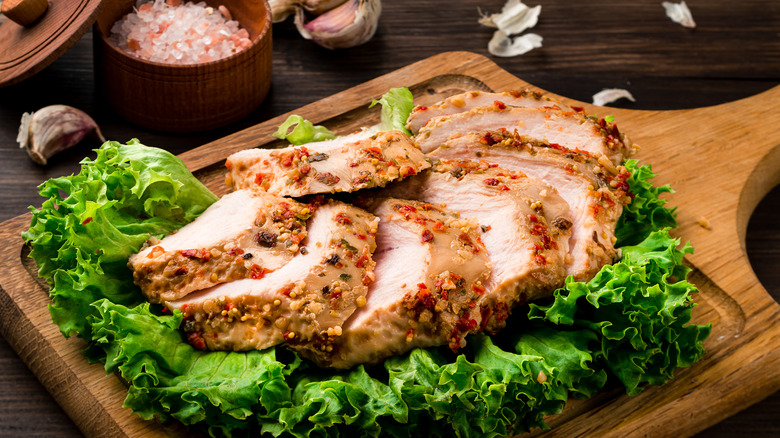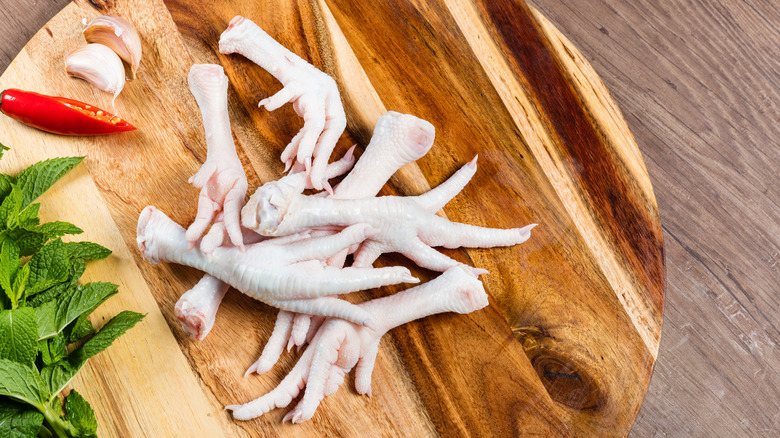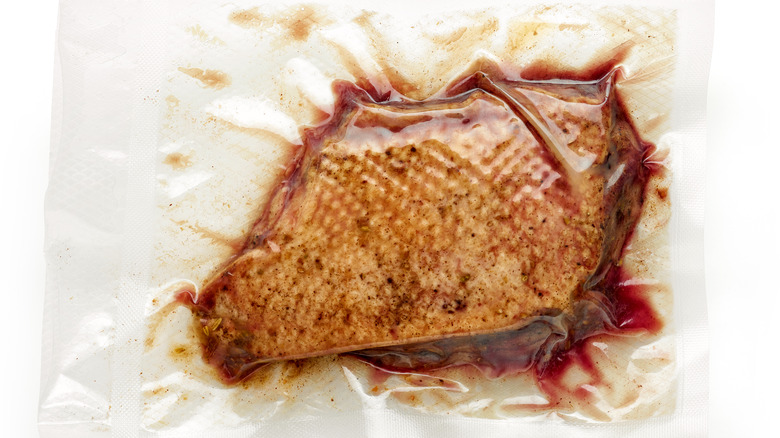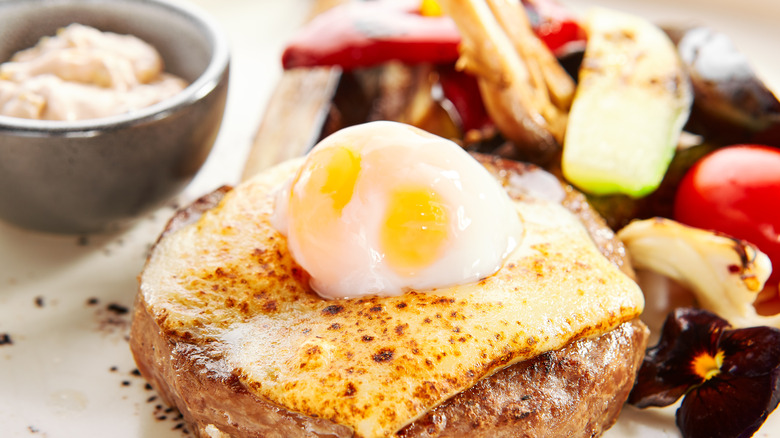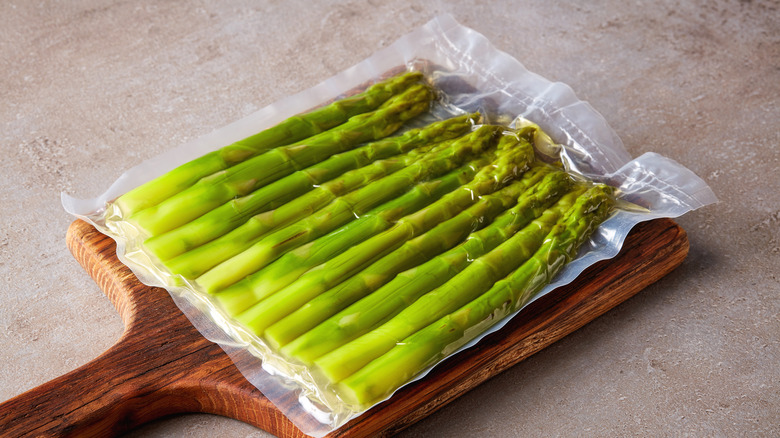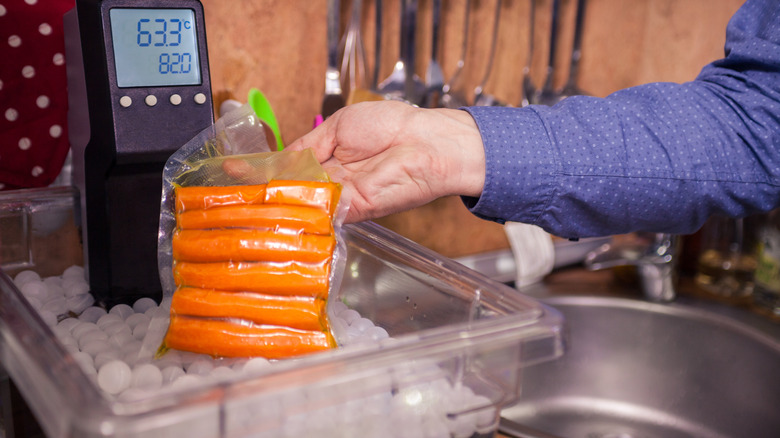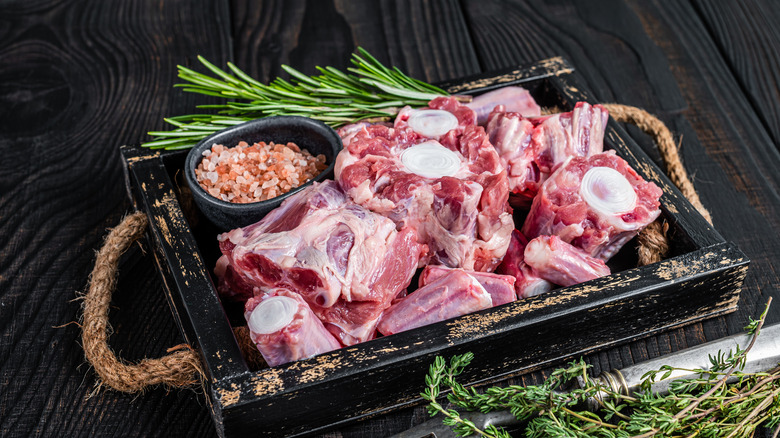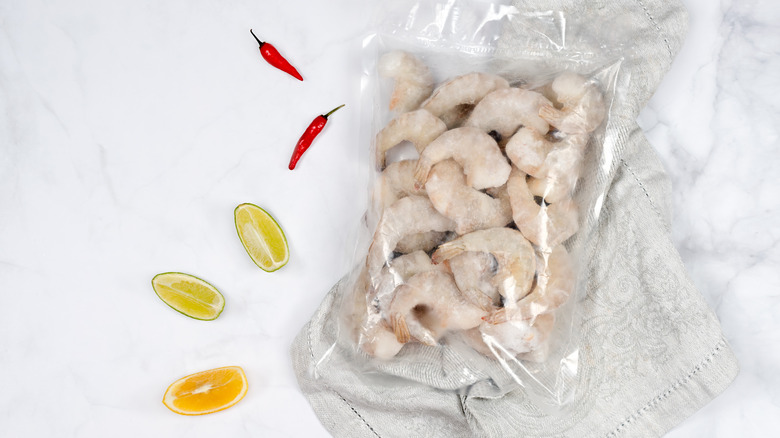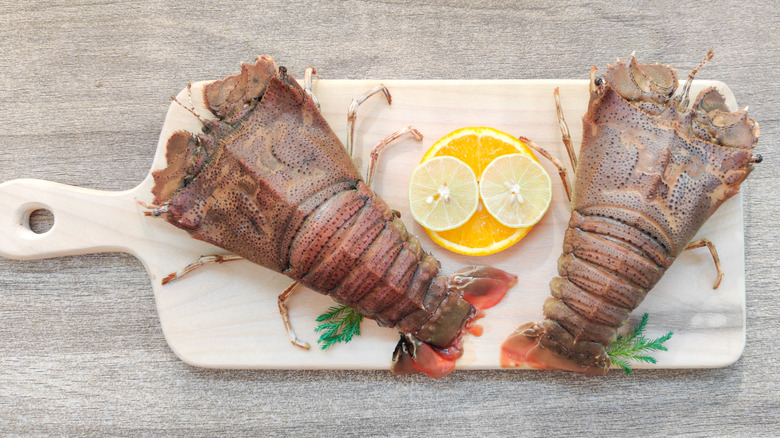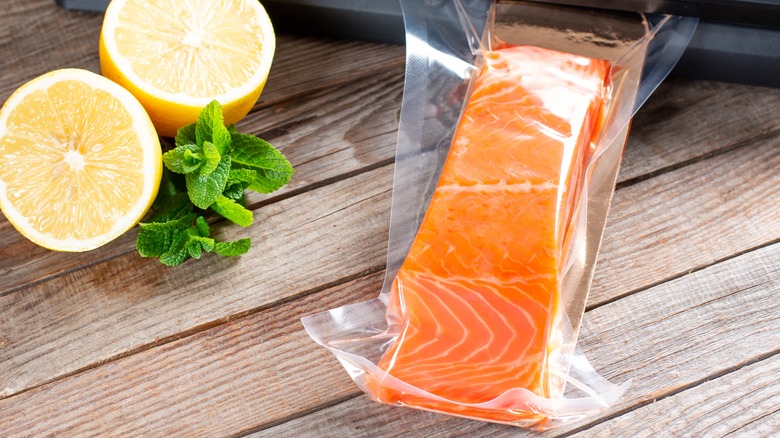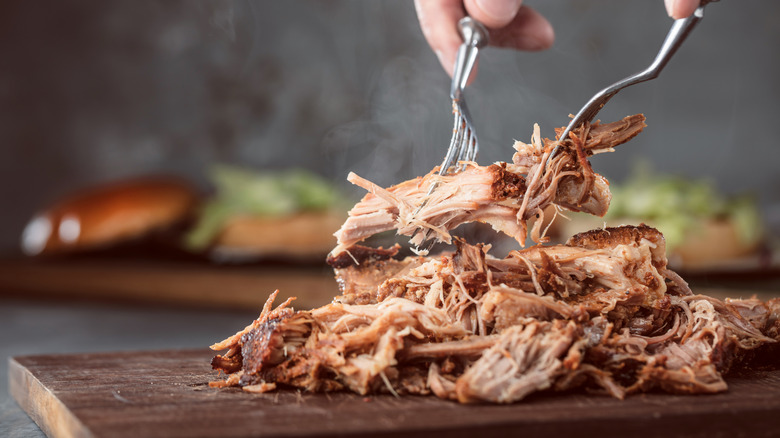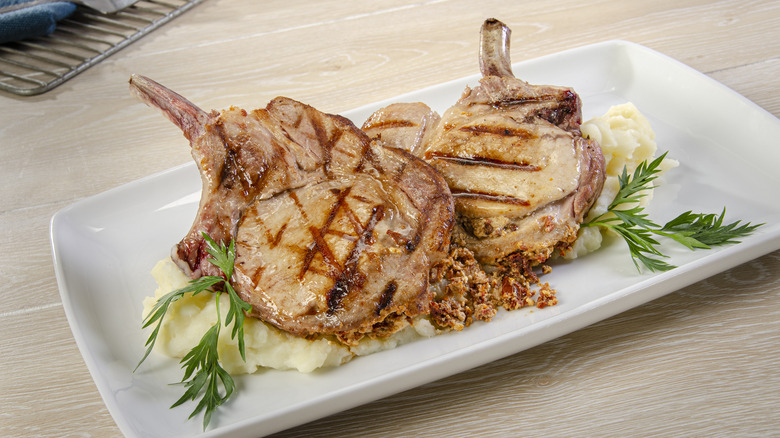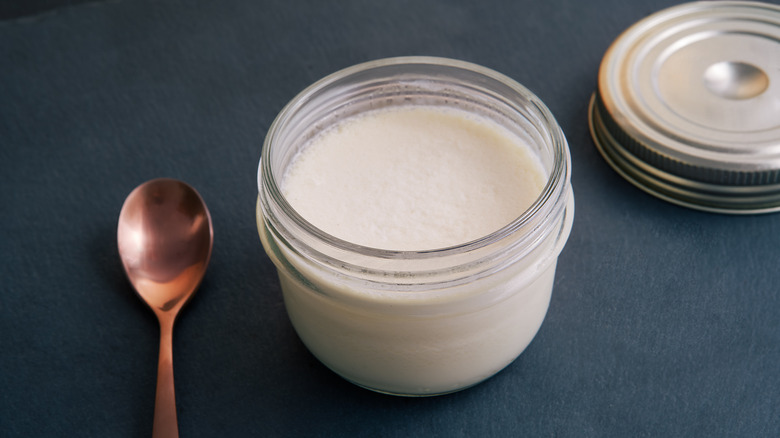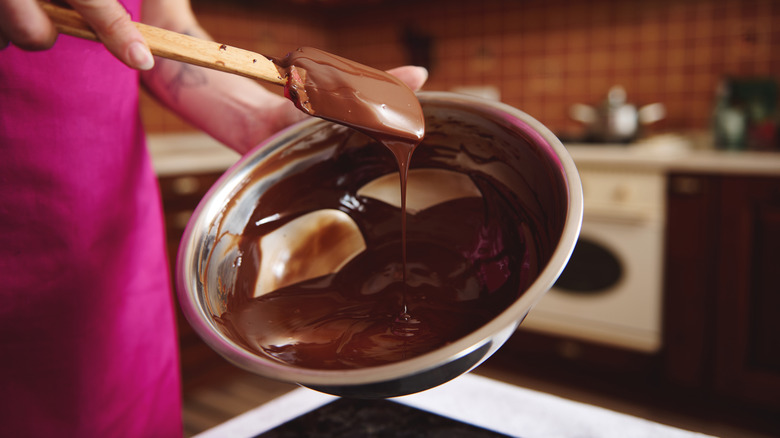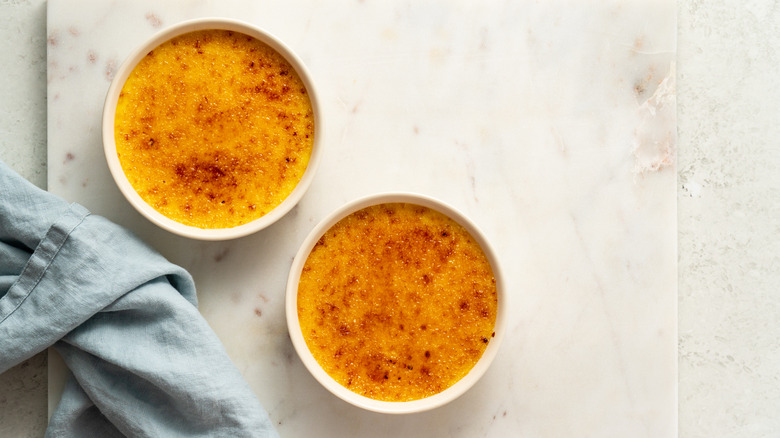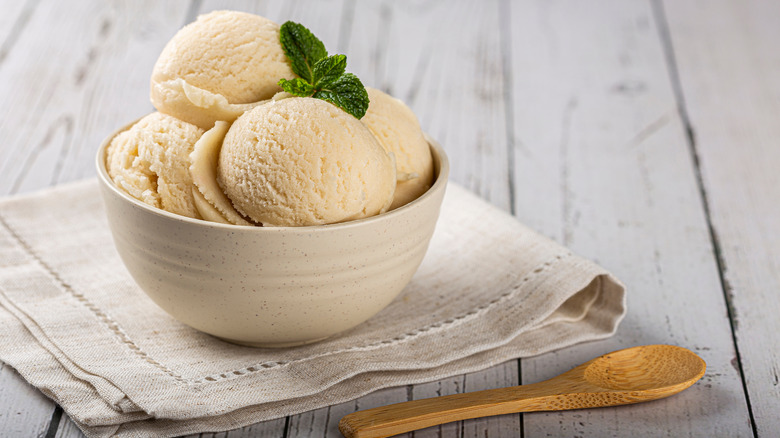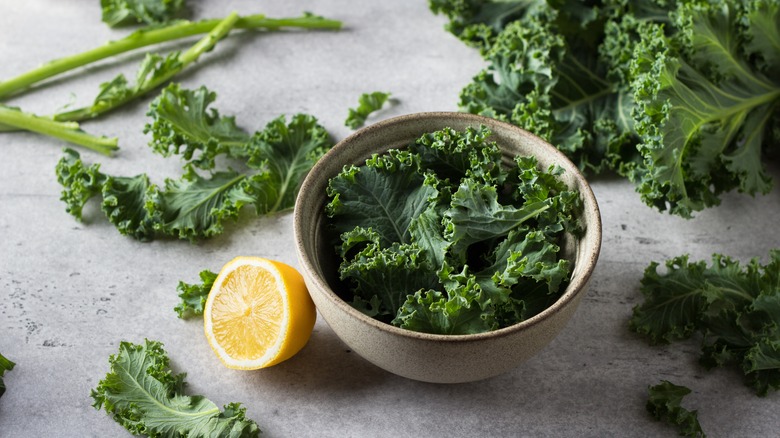The 18 Best Foods You Should Cook Sous Vide
If you're a home cook, there's a good chance that you've heard all about sous vide. It's becoming an increasingly popular method of cooking — and one that often yields absolutely fantastic results. This is because when you decide to use the sous vide method, you're cooking your food very, very slowly at a constant temperature. Sous vide foods are placed into a vacuum-sealed bag and then into a water bath controlled by a sous vide machine. The water is pre-heated to a set temperature, giving you more control over how you cook your food. Sous vide cooking is especially helpful for meats that tend to end up dry or chewy when you cook them with a different method because the meat will never be exposed to excessive temperatures.
Interested in getting into sous vide cooking? It's a lot easier than you may assume. Once you have your sous vide machine and all the necessary ingredients, it's a relatively hands-off process. But before you get cooking, you're probably wondering which foods you should make using this method. We've compiled a list of the absolute best foods to cook sous vide. Give these foods a try, and then go forth into the world of sous vide cooking armed with the knowledge you need to feed yourself, your family, and your guests some of the best meat, seafood, and veggies you've ever tried.
Steak
For those who have a specific method to cook steak that they never veer from, sous vide cooking may sound downright ridiculous. But try it once, and we bet that you'll never fire up the grill again. If you're looking for that elusive rare interior and crispy, crunchy exterior that packs plenty of flavor, you seriously can't go wrong with this method. And since steak is often a more expensive cut of meat, you really don't want to overcook it — sous vide cooking will prevent that from happening. For a juicy rib eye steak, we recommend setting your sous vide to 129 degrees and let your meat cook for two hours. That will give you a medium-rare steak that's cooked to perfection.
Of course, you still need to create that beautiful texture on the crust, so once your steak is out of the sous vide machine, dry it with paper towels and then plop it into a scorching hot cast iron skillet to quickly sear both sides. Remember — you're not trying to cook it through here.
Follow these steps, and we guarantee you'll have an unforgettable steak.
Chicken breast
If there's one cut of meat that is always at risk of getting too dry and ending up flavorless and unappealing, it's chicken breast. Of course, raw chicken can pose health risks, so it's important to cook your chicken all the way though. But that leads many people to overcook their chicken breast, especially when they cook it on the skillet or in the oven. If you love chicken breast but want to enjoy it at its very best, sous vide cooking is the way to go. It's the best way to cook chicken breast, hands down.
Turns out that you actually don't even have to set the temperature on your sous vide machine to 165 F when you're cooking chicken like you may have been taught by your parents. With a precise machine, you can get away with cooking your chicken for longer at a lower temperature, resulting in juicier, more delicious chicken. For this chicken salad recipe, we recommend a two hour bath at 150 degrees to achieve the ideal cook.
When your chicken comes out of the sous vide machine, throw it in a skillet to give it those crispy corners and edges that take chicken breast to the next level. You may never cook a chicken breast the old way again.
Chicken feet
Those who get it, get it, and those who don't, don't. Chicken feet aren't for everyone, but if you've never tried these chewy, flavorful bites, you should at least give them a chance. Unfortunately, they can be difficult to cook due to their texture. If you don't cook them right, you could end up with a hard-to-chew claw that won't be appetizing to anyone. That's why we think sous vide cooking is absolutely perfect for chicken feet. It allows them to hold onto more of their moisture, making them as tender as can be when you're finally ready to dig in.
Per Lifehacker, it's usually a good idea to marinate your chicken feet overnight before you sous vide. This will enhance their taste and allow them to soak up all those flavorful juices before you cook. Now, a warning: It's going to take a while to cook your chicken feet. If you turn on your sous vide machine to 180 degrees, you can allow them to cook for about 24 hours. When they come out of the bag, they may seem a little bit too tender — but that's okay. The next step is frying them on the stovetop until they're nice and golden brown. Pop one into your mouth, and you may just find that you have a new favorite snack on your hands.
Sure, this one may be a labor of love, but we think it's totally worth it.
Duck
Duck is a notoriously difficult meat to cook — especially when it comes to duck breast. And many times, duck breast can be an expensive cut of meat, so you definitely don't want to mess it up by overcooking it. When done correctly, duck breast is tender, juicy, and overall super enjoyable to eat. So why not sous vide it? Lifehacker suggests that you should first season your duck breasts with salt before placing them in the bag and sealing them. You'll want to keep them in the sous vide machine for about two hours at 130 degrees. After that, take them out, and remove the skin as carefully as possible — you don't want to rip it.
Since sous vide cooking doesn't give you that nice crispiness you're looking for in duck, you'll have to heat up a skillet as well. Place the skin in the skillet and cook it until it reaches your desired level of crispiness. Place the skin back on top of the duck breasts, then slice and enjoy. If you always believed that you didn't have the skills or the know-how to cook duck breast, now you can give it a shot, and you don't have to worry about ruining your pricey meat.
Eggs
While eggs may not be the first food you think of when you want to get into sous vide cooking, it turns out that they're actually one of the most popular foods to cook using the method. Since eggs cook so quickly, it can be difficult to get them to the perfect temperature and consistency. Just think about it: How many times have you overcooked a fried egg in your life and have ended up with a completely solid yolk? Probably more times than you can count. But when you decide to sous vide your eggs instead, you won't run into that problem.
How long you'll need to cook your eggs depends on what kind of texture and consistency you're going for, but once you figure out how you like your eggs, this is one of the easiest ways to prepare breakfast. For perfect sous vide poached eggs, we suggest a cook at 145 F for an hour. And since eggs are already nicely contained in their shells, you don't even have to worry about using a vacuum-sealed bag — just plop them in the water and watch them do their thing.
Asparagus
You're not going to want to sous vide every veggie out there, but if there's one you do try, we recommend asparagus. The stalks are hearty enough to hold up to this cooking method, and it results in tender, juicy asparagus that still has just the right amount of bite. If you love asparagus, you can't go wrong by sous vide cooking it. According to Simply Recipes, it'll only take you about 15 minutes total. Set your sous vide machine to 180 degrees, and let the water slowly warm up. Add your asparagus to a bag with all the seasonings you want to include — don't shy away from using plenty of salt if you really want to bring out the flavors of your asparagus. Seal the asparagus in the bag, and cook for six to 10 minutes, depending on the thickness of your stalks.
Once you take your veggies out of the bag, you'll be blown away by their texture (not too soft, with just enough crunch). And the best part of all? This method is really, really easy. Since you're not cooking meat, you don't have to worry about killing off any bacteria, which is generally why sous vide cooking takes longer than other methods.
Carrots
Another veggie to add to your sous vide roster is carrots. Let's be honest: Carrots are notoriously difficult to cook if you're not roasting them. They can come out bland and dry, which isn't exactly going to inspire you to eat more vegetables. But when you decide to sous vide carrots, they're going to be cooking in their juices (and not losing any of that moisture). That will result in ultra-tender carrots that refrain from being mushy, and it dials up the intensity of their natural flavor. Basically, these will be the most carrot-y carrots you've ever eaten.
Serious Eats suggests cooking carrots in 183-degree water to bring out their tenderness. You're going to want to sous vide them for about an hour, but keep checking them regularly to see if they've reached your desired texture. When they're done in the sous vide machine, it'll be time to take them out and throw them in a pan. This "glazes them in their rendered juices, enhancing their flavor and appearance," according to Serious Eats. Sounds pretty amazing to us.
Oxtail
Oxtail may not grace your plate on the regular, but we're here to tell you that it definitely should. You can find plenty of oxtail recipes out there, but you may still be left wondering how you can make yours as flavorful and juicy as possible. Well, you shouldn't be surprised at this point to find out that sous vide cooking your oxtails will make them taste even more incredible than they usually do.
According to ChefSteps, you're first going to cook your oxtails in a sauce on the stove. Remember, since the bone is included, you don't have to worry too much about overcooking, as those bones help the meat retain a lot of its tenderness. Then, add them to the bag and turn up the heat on your sous vide machine.
Once your oxtails are done cooking, you can serve them in a variety of ways. ChefSteps recommends placing them onto a bed of polenta, butternut squash, or mashed potatoes, but the possibilities here really are endless. Don't be afraid to try something new!
Shrimp
Overcooking seafood results in a less-than-pleasant texture that some describe as rubbery. Clearly, that's not what you're going for when you head to your local seafood market. That's why you may want to consider sous vide cooking your shrimp. High-quality shrimp can be expensive, so sous vide cooking will ensure that you don't overcook this very delicate seafood.
Serious Eats offers some much-needed advice on how to sous vide shrimp: use baking soda. This method is often used in Chinese cooking, resulting in firmer shrimp with a "snappy, springy bite to them." After all, the last thing you want is to eat a bunch of mushy shrimp — doesn't exactly sound appealing. Toss your shrimp in baking soda and allow them to sit for about 30 minutes before you start cooking for the best results. You'll be happy with how plump and firm they come out.
Don't be afraid to add plenty of flavors here too. The natural taste of the shrimp will be super-pronounced with this cooking method, so it doesn't hurt to add garlic, shallots, olive oil, or even smoked paprika to a pan after you're done sous vide cooking. Though this method might take some extra time, it's well worth it when you taste how delicious your shrimp will be.
Lobster
How many times a year do you buy a lobster and cook it at home? Unless you're living much better lives than we are, it's probably not that often. And because of that, when it happens, it feels like a special occasion. Therefore, overcooking a lobster that could have been delicious is a colossal waste of money and time. If you want to ensure you're making absolutely perfect lobster every single time, sous vide cooking is the way to go, according to Sous Vide Wizard.
While overcooking the delicate flesh of lobster is really easy when you're boiling it or putting it on the grill, you won't run into the same problem when you decide to sous vide it. Our suggestion? Cook your lobster with butter if you want to make it even more delectable — you can thank us later. While not every type of seafood does well when it's been sous vided, lobster should be at the top of your list of seafoods to try this cooking method with.
Salmon
Salmon is a type of seafood that can be prepared to suit your personal preference. This makes it a great option for sous vide, especially since its ideal cooking temperature will depend on the kind of fish it is. According to Cook's Illustrated, wild salmon is best cooked to an internal temperature of 120 degrees, whereas farmed salmon can retain its moisture at 125 degrees. Preparing the fish this way will help you avoid any chance of overcooking it, which is obviously never ideal.
Sous vide salmon can be as straightforward or elaborate as you want. This salmon recipe, however, keeps things simple, sealing the filets inside the bag with nothing but salt and pepper, garlic cloves, and olive oil. After 45 minutes in a water bath set to 125 degrees, the fish can be removed, seared, and served.
Another reason this seafood works great for sous vide is that a vegetable side, like asparagus, can be cooked along with it right inside the bag. This makes cooking even easier, where the main and side dishes are cooked together, and there is no need for additional pots or pans.
Pulled pork
Pulled pork is one of the many dishes unique to smoking for hours on end until a nearly unparalleled level of tenderness is achieved. The infusion of smoky flavor into the meat is also tough to copy without a smoker. However, not everyone has access to that equipment, and every backyard barbecue deserves a tray of juicy and delicious pulled pork. Sous vide can help bring this southern staple into your own home.
Cooking a pork shoulder low and slow sous vide style after seasoning with whatever rubs you like will allow you to maintain that precise temperature all day long. There are other ways to cook pulled pork, such as in a slow cooker or the oven, but these methods make it more difficult to consistently keep the right temperature for an extended time.
Pulled pork is usually considered a low-maintenance dish, but sous vide pulled pork really takes leisure to another level. You can start the pork in the morning and, once it is time to eat later, remove it from the water bath and vacuum-sealed bag, pull it apart, and mix it with your favorite barbecue sauce. That's all that remains before this crowd-pleaser is ready to be shared.
Pork chops
Pork chops get a bad wrap for being a dry and boring protein option, but well-seasoned, properly cooked ones are really tough to beat–and there is no better way to accomplish that than with the sous vide technique. This cut of pork dries out easily because there is very little fat on it, so if it surpasses the required temperature to keep it tender, the muscle fibers contract too much, and you are left with a tough piece of meat. Despite any copious helping of gravy or sauce, a stiff pork chop just isn't enjoyable.
According to this sous vide pork chops recipe, you can seal up to four seasoned cuts inside the bag with garlic, lemon juice, olive oil, and herbs. Drop them into a water bath at 140 degrees for one hour. After a quick pan-sear, everything you thought you knew about pork chops will be forgotten, and you will realize how tender, delicious, and exciting they can actually be. No drowning in sauce required!
Cheesecake
If you're like most people, when you think of sous vide cooking, savory dishes are what probably first come to mind. But limiting yourself to cooking savory foods in your sous vide machine is selling yourself short, especially if you have a sweet tooth like we do. And one of the best desserts to make in your sous vide machine? Cheesecake. Not only is cheesecake the most delicious dessert on the planet (we will fight for this one), but it's especially easy to make when you decide to sous vide it.
Per Anova Culinary, you can sous vide your cheesecake in little jars, which are the perfect size for single servings. They only take about two hours to make, but most of that time is very hands-off. The end result is a strikingly silky texture so amazing that you'll never want to eat a non-sous vided cheesecake again.
Chocolate
Another food item that requires precise temperatures when cooking–or, in this case, baking–is chocolate. Understanding the process and reason for tempering chocolate is actually easier than many think. According to The Casual Sousvider, the cocoa butter in chocolate contains unstable and stable crystals. When chocolate is simply melted, the stable crystals are broken down, meaning the ingredient takes longer to set and melts easily when touched. To temper chocolate, the other unstable structures must be dismantled while keeping the stable ones intact. If this is accomplished, the chocolate will set quickly, keep its glossy look, remain firm to the touch, and have a snap to it when broken.
Tempering chocolate with the sous vide method is more involved than other ingredients. Still, it remains easier than melting down chocolate in a double boiler and constantly monitoring its temperature. After heating your water bath to 122 degrees, add your bag of vacuum-sealed chocolate for 15 minutes before lowering the temperature to 82 degrees for an additional 10 minutes. Your chocolate will be the exact temperature you need for whatever you are using it for and will be shiny and elegant.
Crème brûlée
Another reason you would need to temper eggs and, therefore, use the sous vide method is to make an elegant, crowd-pleasing dessert classic: crème brûlée.
A great aspect of baking this sweet treat using the sous vide technique is that you can do so in various ways. The most traditional method would be to cook the custard in the water bath and then, after removing it, pour it into individual ramekins to be topped with sugar and blow-torched. Another way to do it is to seal the mixture inside mason jars and then place them in the water bath. That way, you can have individual servings of the custard ready to go for whoever wants them.
Sous vide crème brûlée is also ideal for getting dessert done ahead of entertaining. If you do cook the custard inside the sealed jars, they can last in the refrigerator for up to two weeks. With company over, once it's time for dessert, all you have to do is take them out of the fridge, crack them open, and pass them around.
Ice cream
Seriously, the sous vide possibilities are endless! Homemade ice cream is usually not a recipe people imagine you can easily make at home since the store-bought version or a trip to a local parlor easily satisfies the craving. However, sous vide ice cream will make you rethink what is possible in your very own kitchen.
If you were wondering how an immersion circulator can be set to freezing temperatures, you are right in assuming it can't work this way. However, the sous vide method is implemented to get the mixture to a perfect temperature so that it can set, be chilled, and then churned. According to this recipe, that takes 45 minutes at 185 degrees.
You will still need an ice cream maker to complete this venture, but the worry of leaving the custard too cool or getting it too hot can be tossed aside. With the sous vide technique, you have one less thing to worry about.
Kale
And last but not least is an ingredient you may not have expected to see here at all: kale. We know that kale has had its moment and the food world has moved on by now, but we have to admit that we still love this crunchy, bitter cruciferous vegetable. While there are plenty of super-simple ways to prepare the kale you have sitting in your fridge, why not give sous vide cooking it a try? You may be surprised at the results.
ChefSteps writes that sous vide cooking kale helps you keep the leaves nice and chewy, which is perfect for a variety of recipes, particularly if you're planning on making a soup or a stew. Because the kale cooks in its own juices, it stays really, really flavorful. If you love the taste of kale as is, you're going to enjoy sous vided kale even better.
